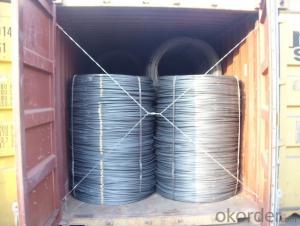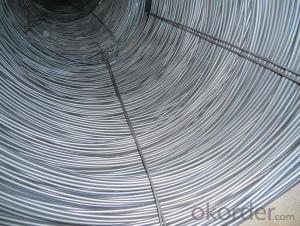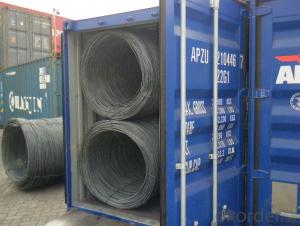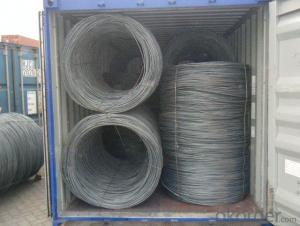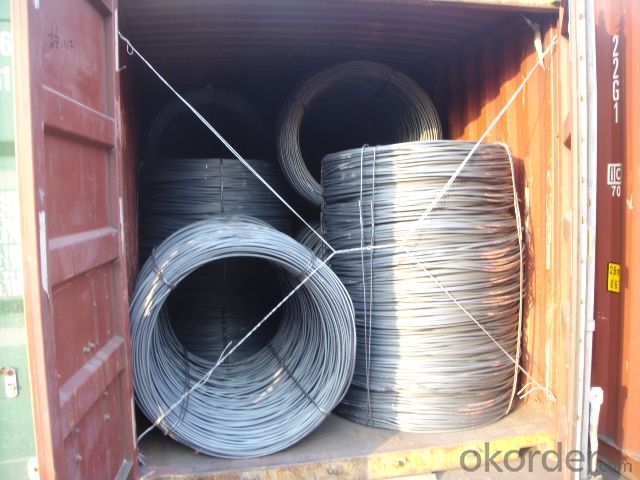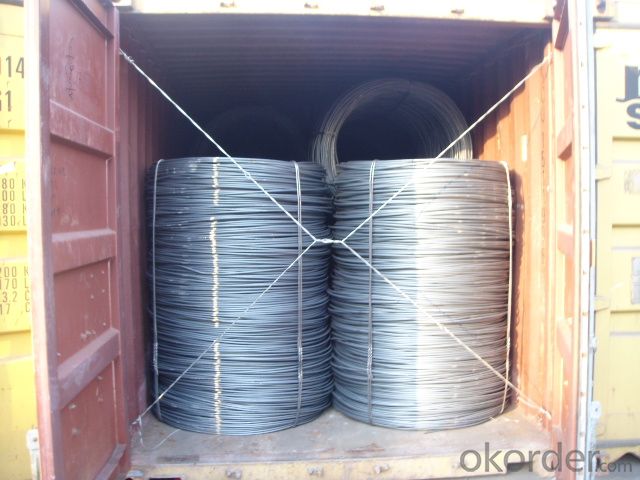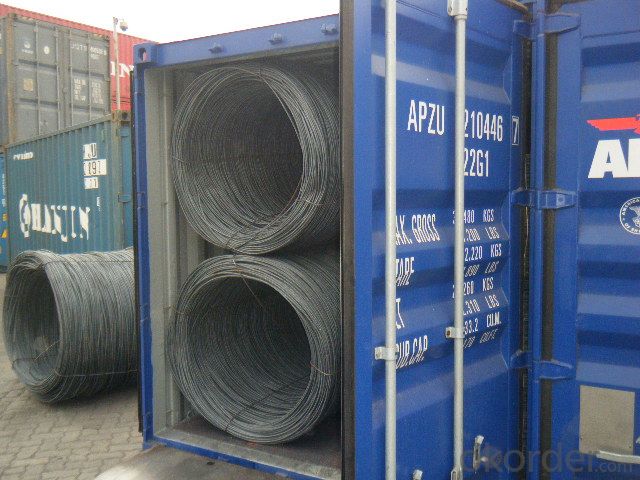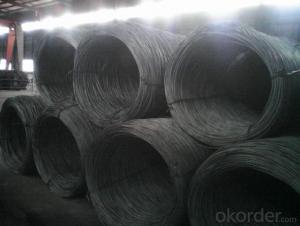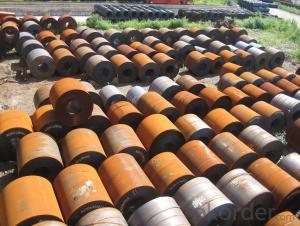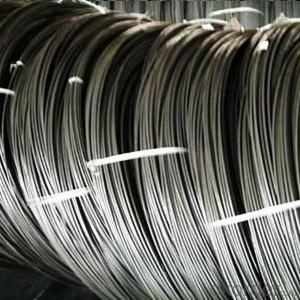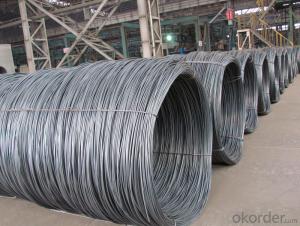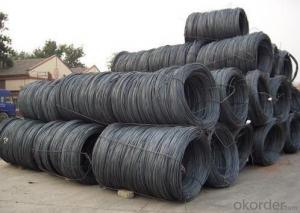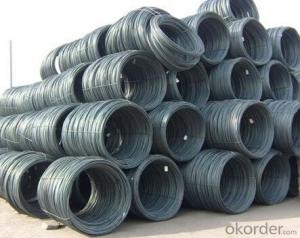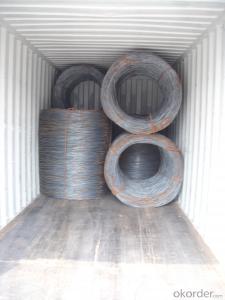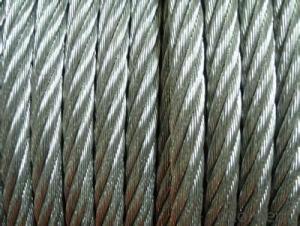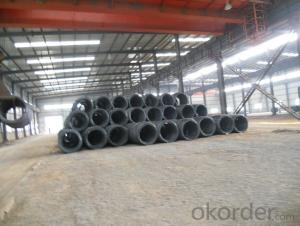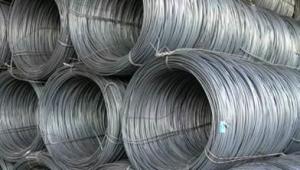Hot Rolled Wire Rod of Steel Grade: Q195/235
- Loading Port:
- Tianjin
- Payment Terms:
- TT OR LC
- Min Order Qty:
- 100 m.t.
- Supply Capability:
- 2000 m.t./month
OKorder Service Pledge
OKorder Financial Service
You Might Also Like
Product Description:
OKorder is offering Hot Rolled Wire Rod of Steel Grade: Q195/235 at great prices with worldwide shipping. Our supplier is a world-class manufacturer of steel, with our products utilized the world over. OKorder annually supplies products to European, North American and Asian markets. We provide quotations within 24 hours of receiving an inquiry and guarantee competitive prices.
Product Applications:
Hot Rolled Wire Rod of Steel Grade: Q195/235 are ideal for structural applications and are widely used in the construction of buildings and bridges, and the manufacturing, petrochemical, and transportation industries.
Product Advantages:
OKorder's Hot Rolled Wire Rod of Steel Grade: Q195/235 are durable, strong, and resist corrosion.
Main Product Features:
· Premium quality
· Prompt delivery & seaworthy packing (30 days after receiving deposit)
· Corrosion resistance
· Can be recycled and reused
· Mill test certification
· Professional Service
· Competitive pricing
Specifications of Hot Rolled Wire Rod:
Steel Grade: Q195/235, SAE1006-1018B Standard: ASTM, GB
Diameter: 5.5mm, 6.5mm, 7mm,8mm,9mm,10mm,12mm,14mm
Type: in coil, coil weight around 2MT Alloy or Not: Alloy
Technique: Hot Rolled
Place of Origin: China Mainland
Surface: round, no twisted, light and smooth
Chemical Composition: (Please kindly find our chemistry of our material based on Q195、Q235A and Q235B as below for your information)
Trademark | Rank | Chemical composition (quality score) % | ||||||
C | Si | Mn | S | P | ||||
| ≤ |
| ≤ | ≤ | ||||
Q195 |
| 0.06-0.12 | 0.30 | 0.25 | 0.050 | 0.045 | ||
Q235 | A | 0.14-0.22 | 0.30 | 0.30-0.65 | 0.050 | 0.045 | ||
Q235 | B | 0.12-0.20 | 0.30 | 0.30-0.70 | 0.045 | 0.045 | ||
Usage and Applications of Hot Rolled Wire Rod:
After hot-rolled the products shaped into coil and delivery as finished product, including round, square, rectangular, hexagonal and so on. Since most of the products are round, it is generally called wire rod. Carbon steel wire rod is widely used in construction and manufacturing. Carbon steel wire rod is mainly used for reinforcement of reinforced concrete and welded structure or reprocessed (roberts , nail, etc.) materials, especially used to produce wire drawing, welding electrode, nails, spring, electronic, precise machinery parts and so on.
Packaging & Delivery of Hot Rolled Wire Rod:
Packaging Detail: products are packed in coil, each coil weight around 2 MT, and then shipped by container or bulk vessel
Delivery Detail: within 45 days after received deposit or LC.
Label: to be specified by customer, generally, each bundle has 1-2 labels
Trade terms: FOB, CFR, CIF
FAQ:
Q1: Why buy Materials & Equipment from OKorder.com?
A1: All products offered byOKorder.com are carefully selected from China's most reliable manufacturing enterprises. Through its ISO certifications, OKorder.com adheres to the highest standards and a commitment to supply chain safety and customer satisfaction.
Q2: How do we guarantee the quality of our products?
A2: We have established an advanced quality management system which conducts strict quality tests at every step, from raw materials to the final product. At the same time, we provide extensive follow-up service assurances as required.
Q3: How soon can we receive the product after purchase?
A3: Within three days of placing an order, we will begin production. The specific shipping date is dependent upon international and government factors, but is typically 7 to 10 workdays.
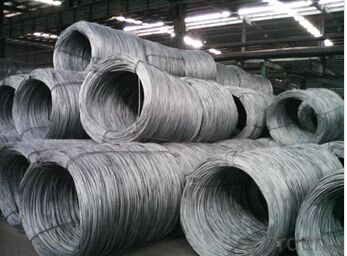
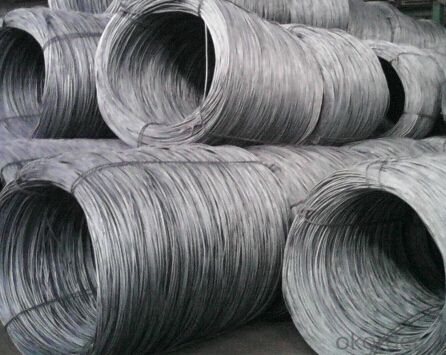
- Q: What are the different surface inspection methods for steel wire rod?
- There are several surface inspection methods for steel wire rods, including visual inspection, magnetic particle inspection, eddy current inspection, and ultrasonic inspection. Visual inspection involves physically examining the surface for any defects or abnormalities. Magnetic particle inspection uses magnetic fields and iron particles to detect surface cracks or discontinuities. Eddy current inspection uses electromagnetic induction to detect surface defects or variations in conductivity. Ultrasonic inspection uses high-frequency sound waves to detect internal and surface defects in the wire rod.
- Q: What are the safety requirements for steel wire rod used in mining wire ropes?
- The safety requirements for steel wire rod used in mining wire ropes are crucial to ensure the safe and reliable operation of mining equipment. These requirements are necessary to prevent accidents, injuries, and fatalities that may occur due to the failure of wire ropes. 1. Material Composition: The steel wire rod used in mining wire ropes must be manufactured from high-quality steel with specific properties to withstand the demanding conditions in mining operations. It should have a high tensile strength, excellent fatigue resistance, and good ductility. 2. Strength and Durability: The wire rod should meet specific strength requirements to ensure it can handle the load and stress associated with mining activities. It must be able to withstand heavy loads, sudden impacts, and repetitive bending and flexing without showing signs of fatigue or failure. 3. Surface Quality: The surface of the steel wire rod should be smooth and free from any cracks, deformations, or defects that could compromise the integrity of the wire rope. A rough or uneven surface can lead to increased friction, wear, and potential failures during operation. 4. Dimensional Accuracy: The wire rod should adhere to precise dimensional tolerances to ensure compatibility with other components of the wire rope system. Accurate dimensions are necessary for proper assembly, fitting, and functionality of the wire rope. 5. Heat Treatment: Proper heat treatment processes, such as annealing or quenching, should be applied to the wire rod to enhance its mechanical properties. Heat treatment can improve the strength, hardness, and resistance to wear and corrosion, making the wire rope more reliable and durable. 6. Quality Control: Rigorous quality control measures should be implemented during the manufacturing process to ensure the wire rod meets the specified safety requirements. Regular inspections, testing, and certifications should be carried out to verify the material's compliance with industry standards and regulations. 7. Documentation and Traceability: It is essential to maintain accurate documentation and traceability records for the steel wire rod used in mining wire ropes. This allows for proper tracking of the material's origin, manufacturing process, and quality control procedures, ensuring accountability and facilitating any necessary investigations or recalls. Adhering to these safety requirements for steel wire rod used in mining wire ropes is crucial to maintaining the integrity and reliability of the equipment. Regular inspection and maintenance of the wire ropes should also be conducted to ensure their continued safe operation.
- Q: How is steel wire rod used in the manufacturing of wire for fishing lines?
- Steel wire rod holds immense significance in the manufacturing procedure for fishing line wire. It functions as the primary material that undergoes a range of processes to convert it into the desired fishing line. To commence, careful selection of the steel wire rod is conducted based on its quality, strength, and durability. This is to assure that the final fishing line possesses the essential properties to endure the demanding conditions encountered during fishing. The first stage in the manufacturing process requires the steel wire rod to be drawn through a series of dies in order to reduce its diameter. This drawing procedure is repeated several times until the desired thickness and diameter are attained. The significance of this step lies in its ability to determine the strength and flexibility of the fishing line. Subsequently, the drawn steel wire rod is coated with a protective layer. This coating can be composed of diverse materials like nylon or polymer, which enhance the fishing line's resistance against abrasion, UV rays, and water damage. Additionally, this protective layer provides supplementary strength and flexibility to the fishing line. Following the coating process, the steel wire rod is further processed to introduce specific features to the fishing line. For instance, it can be twisted or braided to enhance its strength and durability. This process of twisting or braiding also aids in preventing the fishing line from tangling or forming knots while fishing. Lastly, the steel wire rod is cut into the desired length and spooled onto reels or packaged in smaller coils. This ensures that the fishing lines are readily prepared for usage by anglers who can confidently attach them to their fishing rods and embark on their fishing activities. To summarize, steel wire rod plays an integral role in the manufacturing of fishing lines. It undergoes various processes such as drawing, coating, twisting, and cutting to transform it into robust, long-lasting, and flexible fishing lines that can withstand the rigorous conditions encountered during fishing.
- Q: How is steel wire rod used in the manufacturing of wire mesh grilles?
- Steel wire rod is used in the manufacturing of wire mesh grilles as it serves as the primary material for creating the individual wires that form the mesh. The wire rod is first drawn through a series of dies to reduce its diameter and increase its length, resulting in thin and elongated wires. These wires are then woven or welded together to construct the wire mesh grille, providing strength, durability, and a structured pattern that allows for air circulation and visibility while also offering security and protection.
- Q: How is steel wire rod used in the manufacturing of electrical cables?
- Due to its exceptional strength and conductivity properties, steel wire rod is widely employed in the production of electrical cables. Typically, the wire rod undergoes a process called wire drawing, where it is pulled through a succession of dies to decrease its diameter and increase its length. Consequently, this procedure yields a fine, top-notch wire capable of functioning as a conductor in electrical applications. Acting as the central conductor of the cable, the steel wire rod allows for the passage of electrical current. Its high conductivity guarantees minimal power loss during transmission, rendering it an optimal choice for electrical purposes. Moreover, the robustness of steel wire rod enables the cable to endure mechanical stress and strain, guaranteeing its long-lasting durability. During the manufacturing process, it is common practice to apply a layer of insulating material, such as PVC or polyethylene, to the steel wire rod. This insulation layer serves the purpose of providing electrical insulation and safeguarding against moisture and other environmental factors. Consequently, the risk of short circuits is minimized, ensuring the secure and efficient transmission of electricity. Additionally, steel wire rod is utilized in the armor layer of specific types of electrical cables. By encasing the core conductor with wire rod, the cable gains an extra layer of mechanical protection, making it more resistant to bending, crushing, and external impacts. All in all, the utilization of steel wire rod is of utmost importance in the manufacturing process of electrical cables. Its presence as a robust and conductive core conductor guarantees the safe and dependable transmission of electricity, all while preserving the structural integrity of the cable.
- Q: How is steel wire rod used in the manufacturing of wire displays?
- Steel wire rod is commonly used in the manufacturing of wire displays as it serves as the primary raw material for creating the wire frames and structures. The steel wire rod is processed through various manufacturing techniques such as cutting, bending, and welding to form the desired shape and size of the wire displays. It provides strength, durability, and versatility to the wire displays, making them suitable for various applications such as retail shelving, product displays, and exhibition stands.
- Q: What are the common applications of carbon steel wire rod?
- Due to its exceptional mechanical properties and versatility, carbon steel wire rod is extensively utilized in various industries. Here, we present some common uses of carbon steel wire rod: 1. Construction: The construction industry heavily relies on carbon steel wire rod to reinforce concrete structures. It is commonly employed in the production of wire mesh, reinforcement bars, and pre-stressed concrete products. 2. Automotive: In the automotive sector, carbon steel wire rod is employed to manufacture springs, suspension components, and wire harnesses. Its remarkable strength and flexibility make it an ideal choice for these applications, ensuring reliable performance and durability. 3. Manufacturing: Carbon steel wire rod is widely employed in several manufacturing processes, including wire drawing, cold heading, and cold forging. It is commonly used to produce fasteners, bolts, nuts, and other small metal components. 4. Agriculture: The agricultural industry extensively utilizes carbon steel wire rod for applications such as fencing, vineyard trellising, and animal enclosures. With its high tensile strength and corrosion resistance, it proves to be an ideal material for outdoor use. 5. Wire Products: Carbon steel wire rod serves as the primary raw material for the production of a wide range of wire products, including cables, wire ropes, and galvanized wires. These products find applications in industries such as telecommunications, construction, and manufacturing. 6. Energy and Power: The energy and power sector relies on carbon steel wire rod for manufacturing electrical transmission and distribution lines. It provides the necessary strength and conductivity required for efficient power transmission. 7. Furniture and Household Goods: Carbon steel wire rod is utilized in the production of furniture, kitchenware, and other household goods. Its ability to be shaped into various forms provides structural support and durability to these products. In conclusion, carbon steel wire rod finds extensive applications in the construction, automotive, manufacturing, agriculture, wire products, energy and power, as well as furniture and household goods industries. Its mechanical properties, versatility, and cost-effectiveness contribute to its popularity in various applications.
- Q: What are the safety precautions to be taken while working with steel wire rod?
- When working with steel wire rods, it is important to follow certain safety precautions to ensure a safe working environment. Some of the precautions include wearing appropriate personal protective equipment (PPE) such as gloves, safety glasses, and steel-toed boots to protect against potential injuries. Additionally, workers should be trained on proper handling techniques, ensuring they are familiar with the weight and dimensions of the wire rods to prevent strain or accidents. It is crucial to use the right tools and equipment for cutting, bending, or manipulating the wire rods to minimize the risk of injury. Regular inspections of the wire rods for any defects or damages are also necessary to prevent accidents. Lastly, maintaining a clean and organized workspace, removing tripping hazards, and implementing proper storage procedures for the wire rods are essential to prevent accidents and injuries.
- Q: What are the different surface finishes available for processed steel wire rod?
- Some of the different surface finishes available for processed steel wire rod include black oxide, galvanized, polished, and coated finishes.
- Q: How is steel wire rod used in the manufacturing of wire forms for elevator cables?
- Steel wire rod is a crucial component in the manufacturing of wire forms for elevator cables. The steel wire rod is first processed and drawn into a specific diameter and shape to meet the required strength and flexibility needed for elevator cables. The wire rod is then heated and coated with a protective layer to enhance its durability and resistance against corrosion. Once the steel wire rod is prepared, it is further processed to form wire strands. These wire strands are then twisted together to create elevator cables with the desired strength and load-bearing capacity. The number of wire strands and the tightness of the twisting are determined by the specific requirements of the elevator cable. The use of steel wire rod in the manufacturing of wire forms for elevator cables ensures the cables can withstand the heavy loads and continuous movement involved in elevator operation. The strength and flexibility of the steel wire rod contribute to the overall safety and reliability of the elevator cables. Additionally, the steel wire rod used in elevator cable manufacturing undergoes strict quality control measures to meet industry standards and regulations. This ensures that the wire forms produced using steel wire rod are of high quality, capable of withstanding the rigorous demands of elevator systems. In conclusion, steel wire rod plays a vital role in the manufacturing of wire forms for elevator cables. Its strength, flexibility, and durability are essential for creating elevator cables that can safely and reliably transport passengers and goods within buildings.
Send your message to us
Hot Rolled Wire Rod of Steel Grade: Q195/235
- Loading Port:
- Tianjin
- Payment Terms:
- TT OR LC
- Min Order Qty:
- 100 m.t.
- Supply Capability:
- 2000 m.t./month
OKorder Service Pledge
OKorder Financial Service
Similar products
Hot products
Hot Searches
Related keywords

